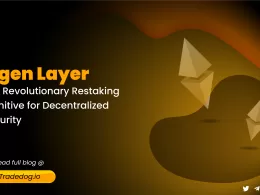Quick Links
In our increasingly interconnected world, where information streams are constantly monitored and filtered, censorship-resistant blockchain networks emerge as a powerful force for free speech and unfettered transactions. But what exactly are they, and how do they revolutionize the way we interact and conduct business online?
Understanding Censorship Resistance
In the world of blockchain, censorship resistance signifies a network’s built-in defense against attempts to limit participation, tamper with data, or alter transactions. This translates into three key features that grant users significant power:
Open Participation: Unlike traditional systems or social media platforms with strict gatekeepers, censorship-resistant blockchains are bastions of inclusivity. Anyone with an internet connection can join the network, regardless of location, age, or political affiliation. This creates a level playing field where everyone has a voice.
Immutable Transactions: Once a transaction is validated and inscribed on the blockchain ledger, it becomes virtually unchangeable. This unwavering immutability ensures a tamper-proof record of all activity on the network. Imagine a permanent, transparent ledger that meticulously tracks every transaction – that’s the power of immutability.
Decentralized Governance: A single entity does not dictate decisions concerning the network’s protocol but rather established through a consensus mechanism where users have a say. This eliminates the risk of a central authority controlling information flow or transactions, fostering a democratic and accountable environment.
Why is Censorship Resistance Important?
Censorship resistance empowers individuals in several profound ways:
- Users gain the ability to conduct financial transactions without fear of being blocked due to political or economic reasons. This is particularly significant for people residing in countries with restrictive financial systems, granting them control over their hard-earned money.
- Censorship-resistant platforms provide a safe haven for open communication and exchange of information, even when it challenges the status quo. This fosters a vibrant space for diverse viewpoints and empowers individuals to speak their truth freely.
- The immutability of transactions fosters trust and transparency within the network. Since all activity is publicly viewable on the blockchain ledger, users can be confident that the system functions with integrity and fairness.
How Do Censorship-Resistant Blockchains Work?
The magic behind censorship resistance lies in the core principles of blockchain technology:
- Decentralization: The network is distributed across a vast number of computers (nodes) scattered worldwide, eliminating a central point of control. This distributed structure makes it incredibly difficult for any single entity to manipulate the network.
- Cryptography: Transactions are secured using robust cryptographic algorithms, akin to unbreakable codes. This ensures that data cannot be tampered with, safeguarding the integrity of the network.
- Consensus Mechanisms: Mechanisms like Proof-of-Work (PoW) or Proof-of-Stake (PoS) act as the network’s backbone. These mechanisms ensure that all nodes agree on the validity of transactions before they are permanently added to the blockchain ledger.
Examples of Censorship-Resistant Blockchains
- Bitcoin: The undisputed pioneer of censorship-resistant blockchains, Bitcoin offers a permissionless network for peer-to-peer transactions. It has been at the forefront of demonstrating the power of decentralized finance and unfettered transactions.
- Ethereum: This programmable blockchain platform takes censorship resistance a step further. It allows for the development of decentralized applications (dApps) that leverage the power of censorship resistance to create a new paradigm for online interaction.
- Zcash (ZEC): Focused on enhancing privacy alongside censorship resistance, Zcash utilizes zero-knowledge proofs. This cryptographic technique allows users to prove they possess certain information (like sufficient funds for a transaction) without revealing the details themselves. This strengthens user privacy while maintaining the transparency of transactions on the blockchain.
Challenges and Limitations
Censorship resistance empowers users, but it’s not a flawless shield. Here are some key challenges developers are tackling:
- Scalability: Censorship-resistant blockchains often face scalability challenges. As the number of users and transactions on the network increases, processing times can slow down significantly. Developers are exploring solutions like Layer-2 chains to keep things moving without compromising decentralization.
- 51% Attack Risk: Although highly improbable for established networks, the theoretical threat of a 51% attack persists. In a Proof-of-Work (PoW) system, if a single entity or group could gain control of over half of the network’s mining power, they could potentially manipulate transactions or disrupt the network. Newer consensus mechanisms like Proof-of-Stake aim to make such attacks economically infeasible.
- Regulation: Governments are still figuring out how to regulate these new technologies. Unclear regulations could stifle innovation. Finding a balance between protecting consumers and fostering progress is key.
- Privacy Concerns: While some censorship-resistant blockchains like Bitcoin offer a degree of pseudonymity, all transactions are ultimately publicly viewable on the blockchain ledger. Privacy-focused blockchains like Monero and Zcash utilize advanced cryptography to address these concerns, but they may face increased regulatory scrutiny as a result.
- Security Vulnerabilities: Like any complex system, bugs in smart contract code or vulnerabilities can be exploited. Regular audits and security improvements are crucial to mitigate these risks.
- Energy Consumption: The Proof-of-Work (PoW), a common consensus mechanism, consumes a lot of energy. Alternative consensus mechanisms like Proof-of-Stake (PoS) are being explored to reduce the environmental footprint of blockchain technology.
Censorship-Resistant vs. Permissioned Blockchains
| Feature | Censorship-Resistant Blockchains | Permissioned Blockchains |
| Access | Open and permissionless. Anyone can join the network. | Restricted. Access is controlled by a central authority. |
| Decentralization | Highly decentralized. No single entity controls the network. | Less decentralized. A central authority manages the network. |
| Censorship Resistance | Transactions cannot be censored or altered. | Transactions can potentially be censored by the central authority. |
| Transaction Speeds | Generally slower due to the need for consensus among all nodes. | Faster transaction processing speeds due to fewer nodes involved. |
| Scalability | Can face scalability challenges as the network grows. | Can potentially scale more efficiently due to centralized control. |
| Privacy | Varies depending on the blockchain. Some offer pseudonymity, while others prioritize privacy. | Privacy features can be implemented by the central authority. |
| Suitability | Ideal for applications requiring open participation, transparency, and resistance to censorship. | Ideal for use cases where speed, privacy control, and consortium-based collaboration are priorities. |
Future Outlook
Censorship resistance remains a core tenet of blockchain technology. As the technology evolves, developers are actively tackling limitations. Advancements like Layer-2 scaling solutions aim to improve transaction processing speeds without compromising decentralization. Additionally, new privacy features like zero-knowledge proofs are being integrated to enhance user privacy while upholding transparency on the blockchain. These exciting developments pave the way for a future where censorship-resistant blockchains are even more robust and user-friendly.









